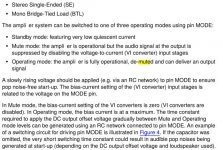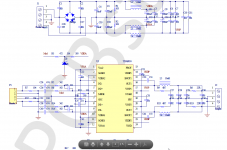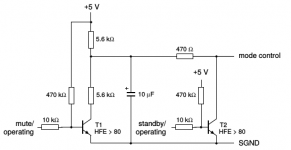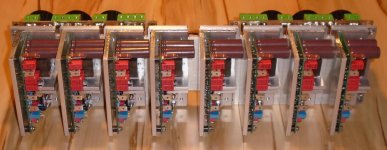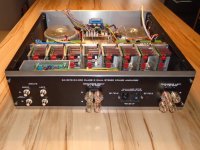Don't work. I can mute by connect mode to gnd and then no noise. I now have mode pin to 800 kohm to 47uF to gnd. This should give me 30 seconds, but i doesn't and still noise
Are you using TDA8924?
You mean you can hear permanent noise if running in mode "ON"?
Measure the Voltage on pin "MODE" to signal ground. In mode "ON" it should be > 4V but not more as 5.5V
You mean you can hear permanent noise if running in mode "ON"?
Measure the Voltage on pin "MODE" to signal ground. In mode "ON" it should be > 4V but not more as 5.5V
TDA8950th - the schematics from connexelectronic is the same for all TDA89xx - at least when I bought it.
I only have noise the first few seconds. When the amp is settlede I can turn it off. When I turn it on shortly after there is no noise.
The noise is similar to the noise when you search for a radiochannel (FM radio)
I only have noise the first few seconds. When the amp is settlede I can turn it off. When I turn it on shortly after there is no noise.
The noise is similar to the noise when you search for a radiochannel (FM radio)
Last edited:
Attached the original mute circuit from datasheet. I have omitted the "standby/operating" switch. If I turn on the power, my TDA8950j circuit goes directly into mute mode. No noise, no click.
Try to use the attached circuit to control mute/operating if it makes any difference.
BR, Toni
To anonymous voter: thank you for the "good" vote.
To all others: maybe your vote is different?
Try to use the attached circuit to control mute/operating if it makes any difference.
BR, Toni
To anonymous voter: thank you for the "good" vote.
To all others: maybe your vote is different?
Attachments
I can mute, If I mute no noise no click no hum. As soon as I go into operating mode (just a wire to gnd = mute and lift the wire = operating mode) the noise is there for few seconds and then everything is normal.
If I need the curcuit I would say the connex module is defect. In newer revisions he states that a RC timedelay is needed on the mode pin, so I really hope I can do with just a resistor and capacitor. I have send a mail to Cristi yesterday - so hope for an answer soon.
If I need the curcuit I would say the connex module is defect. In newer revisions he states that a RC timedelay is needed on the mode pin, so I really hope I can do with just a resistor and capacitor. I have send a mail to Cristi yesterday - so hope for an answer soon.
One of my customers just emailed me and told me what's going on here and I consider that I had to chime in.
First of all I thought that this issue was fixed 4-5 years ago, when you first told me about. We spoke both on the forum and by email and at a point you told me that the issue was fixed and was just improper wiring causing the noise. (I have the email conversations and there are not few)
here you can see that dozens of posts were dedicated to this issue only http://www.diyaudio.com/forums/connexelectronic/158601-class-d-audio-amplifiers.html
Now before I will review the last developments and why is again not working, I just want to know why are you spreading negative information on the forum about our products and my person ?
You made an affirmation that these modules are known to be bad and many customers complain about them. Please bring some solid prof before the matter become serious. at that time I sold over 300 modules identical with yours and beside you, there are no other customers reporting any such issue. and this was the very first TDA89xx amplifier which I sold ! If they were so bad, I couldn't sell at least 1/10 of them and the forum would be full of such threads.
http://www.diyaudio.com/forums/class-d/268572-irs2092-cheap.html
http://www.diyaudio.com/forums/clas...2092k-kit-no-documentation-3.html#post4073161
http://www.diyaudio.com/forums/clas...2092k-kit-no-documentation-3.html#post4075166
First of all I thought that this issue was fixed 4-5 years ago, when you first told me about. We spoke both on the forum and by email and at a point you told me that the issue was fixed and was just improper wiring causing the noise. (I have the email conversations and there are not few)
here you can see that dozens of posts were dedicated to this issue only http://www.diyaudio.com/forums/connexelectronic/158601-class-d-audio-amplifiers.html
Now before I will review the last developments and why is again not working, I just want to know why are you spreading negative information on the forum about our products and my person ?
You made an affirmation that these modules are known to be bad and many customers complain about them. Please bring some solid prof before the matter become serious. at that time I sold over 300 modules identical with yours and beside you, there are no other customers reporting any such issue. and this was the very first TDA89xx amplifier which I sold ! If they were so bad, I couldn't sell at least 1/10 of them and the forum would be full of such threads.
http://www.diyaudio.com/forums/class-d/268572-irs2092-cheap.html
http://www.diyaudio.com/forums/clas...2092k-kit-no-documentation-3.html#post4073161
http://www.diyaudio.com/forums/clas...2092k-kit-no-documentation-3.html#post4075166
These modules a known to have noise untill they settle in.
http://www.diyaudio.com/forums/class-d/267894-tda8950th-still-start-up-noise.html
http://www.diyaudio.com/forums/class-d/267894-tda8950th-still-start-up-noise.html
Hi Cristi. I also have the entire correspodance, and have read it againg and again. The wrong wiring maybe caused some strange noise on piano, but very little. I have to test again to see if that has gone away. Then I also used plastic screws whivh made the modules oscilate, and the chip got very hot. But it worked for some months.
The noise here is the startup noise, and that never went away. I know other also never got rid of this noise with the capacitor solution you suggested.
The modules I try now have never been used before.
The noise here is the startup noise, and that never went away. I know other also never got rid of this noise with the capacitor solution you suggested.
The modules I try now have never been used before.
These modules a known to have noise untill they settle in.
http://www.diyaudio.com/forums/class-d/267894-tda8950th-still-start-up-noise.html
This is my thread 🙂 and I have also written to you from your website
I continue my search for a solution in my own thread
http://www.diyaudio.com/forums/class-d/267894-tda8950th-still-start-up-noise.html
http://www.diyaudio.com/forums/class-d/267894-tda8950th-still-start-up-noise.html
Are you using TDA8924?
You mean you can hear permanent noise if running in mode "ON"?
Measure the Voltage on pin "MODE" to signal ground. In mode "ON" it should be > 4V but not more as 5.5V
I have 4,66 Volt so that should be fine
Rebuilding 4 channel class D amplfifier using IRS2092 modules:
... slow progress, but progress ...
Currently I'm in the process of removing TDA8950 modules and replacing them with the brand new "Class D LiteAmp" modules from Markus AKA ChocoHolic (see link above).
BR, Toni
The TDA8950j has definitely a THD problem in the 5 - 7 kHz range which can be heard playing special audio material e.g. piano music.
...
I'm currently in the process removing the TDA8950j stages and replacing them with IRS2092 based bridging amplifier modules.
Have a look at this project for further information:
http://www.diyaudio.com/forums/class-d/255046-systemd-liteamp.html
Results will be posted in above thread and maybe also here or in a separate thread.
...
... slow progress, but progress ...
Currently I'm in the process of removing TDA8950 modules and replacing them with the brand new "Class D LiteAmp" modules from Markus AKA ChocoHolic (see link above).
BR, Toni
Attachments
I FIXED THE PROBLEM OF MY AMP!!!!!!!!!!!!!!!!
Fortunately the chips are not damaged! 🙂
In my next post I will upload a couple of schematics showing the mistake of the builder of the amp and the solution I made!
So chienmort, don't be afraid to make this amp to use with your bass guitar, it will fit perfectly for the task! I will post shots of my bass boxes too, the upper one of the boxes is in my avatar.
Toni, you gave me the most imortant clue to fix the problem with your answer about the 30Hz injection. Thanks! 😉
I'm curious what your fix was, as you never did post the correction schematic. 🙂 I have the same issue with high distortion at very low levels, almost a fuzz that is overlaying the signal. It is very prominent with solo piano. Please share your fix...if you don't mind!
If we can get rid of that piano fuzz, a lot of people will be happy.
fishintowater reported that he was able to correct some portion of this low level distortion, and that is the information I am looking for. I understand that there will always be a high-ish (0.5%) level of distortion between 5-7kHz, but what I am talking about is much worse than that. I wonder if I don't have the same error on my boards as fishintowater found on his. Maybe I will send a PM.
I can minimize the fuzz by connecting signal gnd to PSU cap gnd with a short thick wire. I also have heavy distortion with only left input and right output, and vice versa (but very low level). Mono application is therefore best I think. I can only hear fuzz with solo instruments or solo vocal. Nickelback etc is no problem.
I can minimize the fuzz by connecting signal gnd to PSU cap gnd with a short thick wire. I also have heavy distortion with only left input and right output, and vice versa (but very low level). Mono application is therefore best I think. I can only hear fuzz with solo instruments or solo vocal. Nickelback etc is no problem.
Thank you for that insight! I will try a ground connection from the signal GND to the main supply star point. I currently have the input configured exactly as outlined in the TDA8924 datasheet application schematic with the input grounds floating. Maybe this is the issue? I have no hum or any other noise, so in that regard the performance is excellent. Strangely, if I reduce the rail voltage slightly, from 30V to 24V, the fuzz distortion reduces significantly. Very strange!
- Home
- Amplifiers
- Class D
- 4 x BTL 300W/8R - a TDA8950j based 4 channel power amplifier
